Sun
Angular size 0.527–0.545°[8] | | |
| Orbital characteristics | ||
|---|---|---|
Mean distance from Milky Way core | 24,000 to 28,000 light-years[9] | |
| Galactic period | 225–250 million years | |
| Velocity |
| |
corona) | ||
| Luminosity | ||
| Color (B-V) | 0.656[16] | |
| Mean radiance | 2.009×107 W·m−2·sr−1 | |
Photosphere composition by mass | ||
The Sun is the star at the center of the Solar System. It is a massive, hot ball of plasma, inflated and heated by energy produced by nuclear fusion reactions at its core. Part of this energy is emitted from its surface as visible light, ultraviolet, and infrared radiation, providing most of the energy for life on Earth. The Sun has been an object of veneration in many cultures. It has been a central subject for astronomical research since antiquity.
The Sun orbits the
The Sun is a G-type main-sequence star (G2V), informally called a yellow dwarf, though its light is actually white. It formed approximately 4.6 billion[a][14][20] years ago from the gravitational collapse of matter within a region of a large molecular cloud. Most of this matter gathered in the center, whereas the rest flattened into an orbiting disk that became the Solar System. The central mass became so hot and dense that it eventually initiated nuclear fusion in its core. It is thought that almost all stars form by this process.
Every second, the Sun's core fuses about 600 million tons of hydrogen into helium and converts 4 million tons of
Etymology
The English word sun developed from
The principal adjectives for the Sun in English are sunny for sunlight and, in technical contexts, solar (
The English
General characteristics
The Sun is a
The Sun is by far the brightest object in the Earth's sky, with an apparent magnitude of −26.74.[31][32] This is about 13 billion times brighter than the next brightest star, Sirius, which has an apparent magnitude of −1.46.
One
The Sun does not have a definite boundary, but its density decreases exponentially with increasing height above the
Composition
The Sun consists mainly of the elements hydrogen and helium. At this time in the Sun's life, they account for 74.9% and 23.8%, respectively, of the mass of the Sun in the photosphere.[45] All heavier elements, called metals in astronomy, account for less than 2% of the mass, with oxygen (roughly 1% of the Sun's mass), carbon (0.3%), neon (0.2%), and iron (0.2%) being the most abundant.[46]
In solar research it is more common to express the abundance of each element in dex, which is a scaled logarithmic unit. ; 'e' is the element in question and nH is number of hydrogen atoms. By definition hydrogen has an abundance of 12, the helium abundance varies between about 10.3 and 10.5 depending on the phase of the solar cycle;[47] carbon is 8.47, neon is 8.29, oxygen is 7.69[48] and iron is 7.62.
The Sun's original chemical composition was inherited from the interstellar medium out of which it formed. Originally it would have been about 71.1% hydrogen, 27.4% helium, and 1.5% heavier elements.[45] The hydrogen and most of the helium in the Sun would have been produced by Big Bang nucleosynthesis in the first 20 minutes of the universe, and the heavier elements were produced by previous generations of stars before the Sun was formed, and spread into the interstellar medium during the final stages of stellar life and by events such as supernovae.[49]
Since the Sun formed, the main fusion process has involved fusing hydrogen into helium. Over the past 4.6 billion years, the amount of helium and its location within the Sun has gradually changed. Within the core, the proportion of helium has increased from about 24% to about 60% due to fusion, and some of the helium and heavy elements have settled from the photosphere toward the center of the Sun because of gravity. The proportions of heavier elements are unchanged. Heat is transferred outward from the Sun's core by radiation rather than by convection (see Radiative zone below), so the fusion products are not lifted outward by heat; they remain in the core[50] and gradually an inner core of helium has begun to form that cannot be fused because presently the Sun's core is not hot or dense enough to fuse helium. In the current photosphere, the helium fraction is reduced, and the metallicity is only 84% of what it was in the protostellar phase (before nuclear fusion in the core started). In the future, helium will continue to accumulate in the core, and in about 5 billion years this gradual build-up will eventually cause the Sun to exit the main sequence and become a red giant.[51]
The chemical composition of the photosphere is normally considered representative of the composition of the primordial Solar System.
Structure and fusion
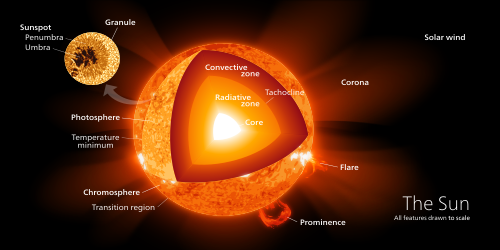
Core
The core of the Sun extends from the center to about 20–25% of the solar radius.[53] It has a density of up to 150 g/cm3[54][55] (about 150 times the density of water) and a temperature of close to 15.7 million kelvin (K).[55] By contrast, the Sun's surface temperature is about 5800 K. Recent analysis of SOHO mission data favors a faster rotation rate in the core than in the radiative zone above.[53] Through most of the Sun's life, energy has been produced by nuclear fusion in the core region through the proton–proton chain; this process converts hydrogen into helium.[56] Currently, only 0.8% of the energy generated in the Sun comes from another sequence of fusion reactions called the CNO cycle, though this proportion is expected to increase as the Sun becomes older and more luminous.[57][58]
The core is the only region of the Sun that produces an appreciable amount of thermal energy through fusion; 99% of the power is generated within 24% of the Sun's radius, and by 30% of the radius, fusion has stopped nearly entirely. The rest of the Sun is heated by this energy as it is transferred outward through many successive layers, finally to the solar photosphere where it escapes into space through radiation (photons) or advection (massive particles).[59][60]

The proton–proton chain occurs around 9.2×1037 times each second in the core, converting about 3.7×1038 protons into
The fusion rate in the core is in a self-correcting equilibrium: a slightly higher rate of fusion would cause the core to heat up more and expand slightly against the weight of the outer layers, reducing the density and hence the fusion rate and correcting the perturbation; and a slightly lower rate would cause the core to cool and shrink slightly, increasing the density and increasing the fusion rate and again reverting it to its present rate.[65][66]
Radiative zone

The radiative zone is the thickest layer of the Sun, at 0.45 solar radii. From the core out to about 0.7
Tachocline
The radiative zone and the convective zone are separated by a transition layer, the
Convective zone
The Sun's convection zone extends from 0.7 solar radii (500,000 km) to near the surface. In this layer, the solar plasma is not dense or hot enough to transfer the heat energy of the interior outward via radiation. Instead, the density of the plasma is low enough to allow convective currents to develop and move the Sun's energy outward towards its surface. Material heated at the tachocline picks up heat and expands, thereby reducing its density and allowing it to rise. As a result, an orderly motion of the mass develops into thermal cells that carry most of the heat outward to the Sun's photosphere above. Once the material diffusively and radiatively cools just beneath the photospheric surface, its density increases, and it sinks to the base of the convection zone, where it again picks up heat from the top of the radiative zone and the convective cycle continues. At the photosphere, the temperature has dropped to 5,700 K (5,430 °C; 9,800 °F) (350-fold) and the density to only 0.2 g/m3 (about 1/10,000 the density of air at sea level, and 1 millionth that of the inner layer of the convective zone).[55]
The thermal columns of the convection zone form an imprint on the surface of the Sun giving it a granular appearance called the
Photosphere
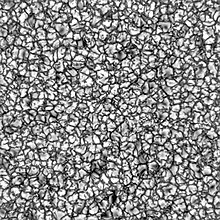
The visible surface of the Sun, the photosphere, is the layer below which the Sun becomes opaque to visible light.[70] Photons produced in this layer escape the Sun through the transparent solar atmosphere above it and become solar radiation, sunlight. The change in opacity is due to the decreasing amount of H− ions, which absorb visible light easily.[70] Conversely, the visible light we see is produced as electrons react with hydrogen atoms to produce H− ions.[71][72]
The photosphere is tens to hundreds of kilometers thick, and is slightly less opaque than air on Earth. Because the upper part of the photosphere is cooler than the lower part, an image of the Sun appears brighter in the center than on the edge or limb of the solar disk, in a phenomenon known as limb darkening.
During early studies of the
Atmosphere
The Sun's atmosphere is composed of four parts: the photosphere (visible under normal conditions), the chromosphere, the transition region, the corona and the heliosphere. During a total solar eclipse, the photosphere is blocked, making the corona visible.[75]
The coolest layer of the Sun is a temperature minimum region extending to about 500 km above the photosphere, and has a temperature of about 4,100 K.[70] This part of the Sun is cool enough to allow for the existence of simple molecules such as carbon monoxide and water, which can be detected via their absorption spectra.[76] The chromosphere, transition region, and corona are much hotter than the surface of the Sun.[70] The reason is not well understood, but evidence suggests that Alfvén waves may have enough energy to heat the corona.[77]
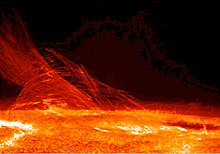
Above the temperature minimum layer is a layer about 2,000 km thick, dominated by a spectrum of emission and absorption lines.[70] It is called the chromosphere from the Greek root chroma, meaning color, because the chromosphere is visible as a colored flash at the beginning and end of total solar eclipses.[67] The temperature of the chromosphere increases gradually with altitude, ranging up to around 20,000 K near the top.[70] In the upper part of the chromosphere helium becomes partially ionized.[78]
Above the chromosphere, in a thin (about 200 km) transition region, the temperature rises rapidly from around 20,000 K in the upper chromosphere to coronal temperatures closer to 1,000,000 K. The corona is the next layer of the Sun. The low corona, near the surface of the Sun, has a particle density around 1015 m−3 to 1016 m−3.[78][e] The average temperature of the corona and solar wind is about 1,000,000–2,000,000 K; however, in the hottest regions it is 8,000,000–20,000,000 K.[79] Although no complete theory yet exists to account for the temperature of the corona, at least some of its heat is known to be from magnetic reconnection.[79][81]
The corona is the extended atmosphere of the Sun, which has a volume much larger than the volume enclosed by the Sun's photosphere. A flow of plasma outward from the Sun into interplanetary space is the solar wind.[81]
The heliosphere, the tenuous outermost atmosphere of the Sun, is filled with solar wind plasma. This outermost layer of the Sun is defined to begin at the distance where the flow of the solar wind becomes superalfvénic—that is, where the flow becomes faster than the speed of Alfvén waves, On April 28, 2021, during its eighth flyby of the Sun, NASA's Parker Solar Probe encountered the specific magnetic and particle conditions at 18.8 solar radii that indicated that it penetrated the Alfvén surface, the boundary separating the corona from the solar wind defined as where the coronal plasma's Alfvén speed and the large-scale solar wind speed are equal.[89][90] The probe measured the solar wind plasma environment with its FIELDS and SWEAP instruments.[91] This event was described by NASA as "touching the Sun".[89] During the flyby, Parker Solar Probe passed into and out of the corona several times. This proved the predictions that the Alfvén critical surface is not shaped like a smooth ball, but has spikes and valleys that wrinkle its surface.[89]
The Sun emits light across the visible spectrum, so its color is white, with a CIE color-space index near (0.3, 0.3), when viewed from space or when the Sun is high in the sky. The Solar radiance per wavelength peaks in the green portion of the spectrum when viewed from space.[92][93] When the Sun is very low in the sky, atmospheric scattering renders the Sun yellow, red, orange, or magenta, and in rare occasions even green or blue. Despite its typical whiteness (white sunrays, white ambient light, white illumination of the Moon, etc.), some cultures mentally picture the Sun as yellow and some even red; the reasons for this are cultural and exact ones are the subject of debate.[94] The Sun is a G2V star, with G2 indicating its surface temperature of approximately 5,778 K (5,505 °C; 9,941 °F), and V that it, like most stars, is a main-sequence star.[59][95]
The 
Sunlight and neutrinos

Ultraviolet light from the Sun has antiseptic properties and can be used to sanitize tools and water. It also causes sunburn, and has other biological effects such as the production of vitamin D and sun tanning. It is also the main cause of skin cancer. Ultraviolet light is strongly attenuated by Earth's ozone layer, so that the amount of UV varies greatly with latitude and has been partially responsible for many biological adaptations, including variations in human skin color in different regions of the Earth.[101]
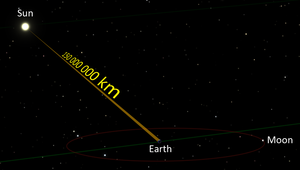
High-energy gamma ray photons initially released with fusion reactions in the core are almost immediately absorbed by the solar plasma of the radiative zone, usually after traveling only a few millimeters. Re-emission happens in a random direction and usually at slightly lower energy. With this sequence of emissions and absorptions, it takes a long time for radiation to reach the Sun's surface. Estimates of the photon travel time range between 10,000 and 170,000 years.[102] In contrast, it takes only 2.3 seconds for neutrinos, which account for about 2% of the total energy production of the Sun, to reach the surface. Because energy transport in the Sun is a process that involves photons in thermodynamic equilibrium with matter, the time scale of energy transport in the Sun is longer, on the order of 30,000,000 years. This is the time it would take the Sun to return to a stable state if the rate of energy generation in its core were suddenly changed.[103]
Neutrinos are also released by fusion reactions in the core, but, unlike photons, they rarely interact with matter, so almost all are able to escape the Sun immediately. For many years, measurements of the number of neutrinos produced in the Sun were
Magnetic activity
The Sun has a stellar magnetic field that varies across its surface. Its polar field is 1–2 gauss (0.0001–0.0002 T), whereas the field is typically 3,000 gauss (0.3 T) in features on the Sun called sunspots and 10–100 gauss (0.001–0.01 T) in solar prominences.[5] The magnetic field varies in time and location. The quasi-periodic 11-year solar cycle is the most prominent variation in which the number and size of sunspots waxes and wanes.[105][106][107]
The solar magnetic field extends well beyond the Sun itself. The electrically conducting solar wind plasma carries the Sun's magnetic field into space, forming what is called the interplanetary magnetic field.[81] In an approximation known as ideal magnetohydrodynamics, plasma particles only move along magnetic field lines. As a result, the outward-flowing solar wind stretches the interplanetary magnetic field outward, forcing it into a roughly radial structure. For a simple dipolar solar magnetic field, with opposite hemispherical polarities on either side of the solar magnetic equator, a thin current sheet is formed in the solar wind.[81]
At great distances, the rotation of the Sun twists the dipolar magnetic field and corresponding current sheet into an Archimedean spiral structure called the Parker spiral.[81] The interplanetary magnetic field is much stronger than the dipole component of the solar magnetic field. The Sun's dipole magnetic field of 50–400 μT (at the photosphere) reduces with the inverse-cube of the distance, leading to a predicted magnetic field of 0.1 nT at the distance of Earth. However, according to spacecraft observations the interplanetary field at Earth's location is around 5 nT, about a hundred times greater.[108] The difference is due to magnetic fields generated by electrical currents in the plasma surrounding the Sun.
Sunspot

Sunspots are visible as dark patches on the Sun's photosphere and correspond to concentrations of magnetic field where convective transport of heat is inhibited from the solar interior to the surface. As a result, sunspots are slightly cooler than the surrounding photosphere, so they appear dark. At a typical solar minimum, few sunspots are visible, and occasionally none can be seen at all. Those that do appear are at high solar latitudes. As the solar cycle progresses toward its maximum, sunspots tend to form closer to the solar equator, a phenomenon known as Spörer's law. The largest sunspots can be tens of thousands of kilometers across.[109]
An 11-year sunspot cycle is half of a 22-year
During the solar cycle's declining phase, energy shifts from the internal toroidal magnetic field to the external poloidal field, and sunspots diminish in number and size. At solar-cycle minimum, the toroidal field is, correspondingly, at minimum strength, sunspots are relatively rare, and the poloidal field is at its maximum strength. With the rise of the next 11-year sunspot cycle, differential rotation shifts magnetic energy back from the poloidal to the toroidal field, but with a polarity that is opposite to the previous cycle. The process carries on continuously, and in an idealized, simplified scenario, each 11-year sunspot cycle corresponds to a change, then, in the overall polarity of the Sun's large-scale magnetic field.[112][113]
Solar activity
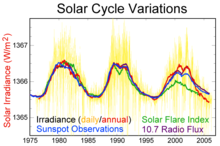
The Sun's magnetic field leads to many effects that are collectively called
Long-term secular change in sunspot number is thought, by some scientists, to be correlated with long-term change in solar irradiance,
In December 2019, a new type of solar magnetic explosion was observed, known as forced magnetic reconnection. Previously, in a process called spontaneous magnetic reconnection, it was observed that the solar magnetic field lines diverge explosively and then converge again instantaneously. Forced Magnetic Reconnection was similar, but it was triggered by an explosion in the corona.[119]
Life phases

The Sun today is roughly halfway through the most stable part of its life. It has not changed dramatically in over four billion[a] years and will remain fairly stable for about five billion more. However, after hydrogen fusion in its core has stopped, the Sun will undergo dramatic changes, both internally and externally. It is more massive than 71 of 75 other stars within 5 pc,[120] or in the top ~5 percent.
Formation
The Sun formed about 4.6 billion years ago from the collapse of part of a giant
The stars HD 162826 and HD 186302 share similarities with the Sun and are thus hypothesized to be its stellar siblings, formed in the same molecular cloud.[129][130]
Main sequence
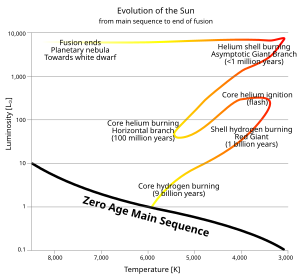
The Sun is about halfway through its main-sequence stage, during which nuclear fusion reactions in its core fuse hydrogen into helium. Each second, more than four million
The Sun is gradually becoming hotter in its core, hotter at the surface, larger in radius, and more luminous during its time on the main sequence: since the beginning of its main sequence life, it has expanded in radius by 15% and the surface has increased in temperature from 5,620 K (5,350 °C; 9,660 °F) to 5,772 K (5,499 °C; 9,930 °F), resulting in a 48% increase in luminosity from 0.677
After core hydrogen exhaustion

The Sun does not have enough mass to explode as a
By the time the Sun reaches the tip of the red-giant branch, it will be about 256 times larger than it is today, with a radius of 1.19 AU (178 million km; 111 million mi).[137][138] The Sun will spend around a billion years in the RGB and lose around a third of its mass.[137]
After the red-giant branch, the Sun has approximately 120 million years of active life left, but much happens. First, the core (full of degenerate helium) ignites violently in the helium flash; it is estimated that 6% of the core—itself 40% of the Sun's mass—will be converted into carbon within a matter of minutes through the triple-alpha process.[139] The Sun then shrinks to around 10 times its current size and 50 times the luminosity, with a temperature a little lower than today. It will then have reached the red clump or horizontal branch, but a star of the Sun's metallicity does not evolve blueward along the horizontal branch. Instead, it just becomes moderately larger and more luminous over about 100 million years as it continues to react helium in the core.[137]
When the helium is exhausted, the Sun will repeat the expansion it followed when the hydrogen in the core was exhausted. This time, however, it all happens faster, and the Sun becomes larger and more luminous. This is the
Models vary depending on the rate and timing of mass loss. Models that have higher mass loss on the red-giant branch produce smaller, less luminous stars at the tip of the asymptotic giant branch, perhaps only 2,000 times the luminosity and less than 200 times the radius.[137] For the Sun, four thermal pulses are predicted before it completely loses its outer envelope and starts to make a planetary nebula. By the end of that phase—lasting approximately 500,000 years—the Sun will only have about half of its current mass.
The post-asymptotic-giant-branch evolution is even faster. The luminosity stays approximately constant as the temperature increases, with the ejected half of the Sun's mass becoming ionized into a planetary nebula as the exposed core reaches 30,000 K (29,700 °C; 53,500 °F), as if it is in a sort of blue loop. The final naked core, a white dwarf, will have a temperature of over 100,000 K (100,000 °C; 180,000 °F) and contain an estimated 54.05% of the Sun's present-day mass.[137] The planetary nebula will disperse in about 10,000 years, but the white dwarf will survive for trillions of years before fading to a hypothetical super-dense black dwarf.[141][142] As such, it would give off no more energy for an even longer time than it was a white dwarf.[143]
Location
Solar System

The Sun has eight known planets orbiting it. This includes four
The Sun is moved by the gravitational pull of the planets. The center of the Sun is always within 2.2 solar radii of the barycenter. This motion of the Sun is mainly due to the four large planets. Each planet in the series Jupiter, Saturn, Neptune, Uranus has about twice as much effect (moment of inertia) as the next. For some periods of several decades (when Neptune and Uranus are in
Celestial neighborhood

Within ten light-years of the Sun there are relatively few stars, the closest being the triple star system Alpha Centauri, which is about 4.4 light-years away and may be in the Local Bubble's G-Cloud.[149] Alpha Centauri A and B are a closely tied pair of Sun-like stars, whereas the closest star to Earth, the small red dwarf Proxima Centauri, orbits the pair at a distance of 0.2 light-year. In 2016, a potentially habitable exoplanet was found to be orbiting Proxima Centauri, called Proxima Centauri b, the closest confirmed exoplanet to the Sun.[150]
The Solar System is surrounded by the Local Interstellar Cloud, although it is not clear if it is embedded in the Local Interstellar Cloud or if it lies just outside the cloud's edge.[151][152] Multiple other interstellar clouds exist in the region within 300 light-years of the Sun, known as the Local Bubble.[152] The latter feature is an hourglass-shaped cavity or superbubble in the interstellar medium roughly 300 light-years across. The bubble is suffused with high-temperature plasma, suggesting that it may be the product of several recent supernovae.[153]
The Local Bubble is a small superbubble compared to the neighboring wider
The
Motion
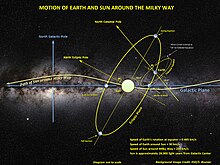
Being part of the Milky Way galaxy the Sun, taking along the whole Solar System, moves in an orbital fashion around
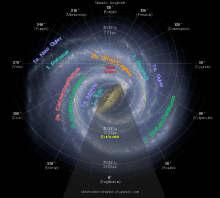
Observational history
Early understanding

The Sun has been an object of veneration in many cultures throughout human history. Humanity's most fundamental understanding of the Sun is as the luminous disk in the sky, whose presence above the horizon causes day and whose absence causes night. In many prehistoric and ancient cultures, the Sun was thought to be a solar deity or other supernatural entity. The Sun has played an important part in many world religions, as described in a later section.
In the early first millennium BC, Babylonian astronomers observed that the Sun's motion along the ecliptic is not uniform, though they did not know why; it is today known that this is due to the movement of Earth in an elliptic orbit around the Sun, with Earth moving faster when it is nearer to the Sun at perihelion and moving slower when it is farther away at aphelion.[162]
One of the first people to offer a scientific or philosophical explanation for the Sun was the Greek philosopher Anaxagoras. He reasoned that it was not the chariot of Helios, but instead a giant flaming ball of metal even larger than the land of the Peloponnesus and that the Moon reflected the light of the Sun.[163] For teaching this heresy, he was imprisoned by the authorities and sentenced to death, though he was later released through the intervention of Pericles. Eratosthenes estimated the distance between Earth and the Sun in the third century BC as "of stadia myriads 400 and 80000", the translation of which is ambiguous, implying either 4,080,000 stadia (755,000 km) or 804,000,000 stadia (148 to 153 million kilometers or 0.99 to 1.02 AU); the latter value is correct to within a few percent. In the first century AD, Ptolemy estimated the distance as 1,210 times the radius of Earth, approximately 7.71 million kilometers (0.0515 AU).[164]
The theory that the Sun is the center around which the planets orbit was first proposed by the ancient Greek Aristarchus of Samos in the third century BC, and later adopted by Seleucus of Seleucia (see Heliocentrism). This view was developed in a more detailed mathematical model of a heliocentric system in the 16th century by Nicolaus Copernicus.
Development of scientific understanding

Observations of sunspots were recorded during the
From an observation of a
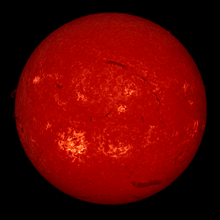
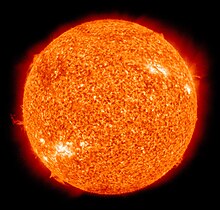
In 1666,
In the early years of the modern scientific era, the source of the Sun's energy was a significant puzzle.
Not until 1904 was a documented solution offered. Ernest Rutherford suggested that the Sun's output could be maintained by an internal source of heat, and suggested radioactive decay as the source.[175] However, it would be Albert Einstein who would provide the essential clue to the source of the Sun's energy output with his mass–energy equivalence relation E = mc2.[176] In 1920, Sir Arthur Eddington proposed that the pressures and temperatures at the core of the Sun could produce a nuclear fusion reaction that merged hydrogen (protons) into helium nuclei, resulting in a production of energy from the net change in mass.[177] The preponderance of hydrogen in the Sun was confirmed in 1925 by Cecilia Payne using the ionization theory developed by Meghnad Saha. The theoretical concept of fusion was developed in the 1930s by the astrophysicists Subrahmanyan Chandrasekhar and Hans Bethe. Hans Bethe calculated the details of the two main energy-producing nuclear reactions that power the Sun.[178][179] In 1957, Margaret Burbidge, Geoffrey Burbidge, William Fowler and Fred Hoyle showed that most of the elements in the universe have been synthesized by nuclear reactions inside stars, some like the Sun.[180]
Solar space missions
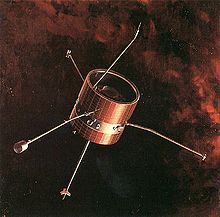
The first satellites designed for long term observation of the Sun from interplanetary space were NASA's
In the 1970s, two Helios spacecraft and the Skylab Apollo Telescope Mount provided scientists with significant new data on solar wind and the solar corona. The Helios 1 and 2 probes were U.S.–German collaborations that studied the solar wind from an orbit carrying the spacecraft inside Mercury's orbit at perihelion.[183] The Skylab space station, launched by NASA in 1973, included a solar observatory module called the Apollo Telescope Mount that was operated by astronauts resident on the station.[80] Skylab made the first time-resolved observations of the solar transition region and of ultraviolet emissions from the solar corona.[80] Discoveries included the first observations of coronal mass ejections, then called "coronal transients", and of coronal holes, now known to be intimately associated with the solar wind.[183]
In the 1970s, much research focused on the abundances of

In 1980, the
Launched in 1991, Japan's Yohkoh (Sunbeam) satellite observed solar flares at X-ray wavelengths. Mission data allowed scientists to identify several different types of flares and demonstrated that the corona away from regions of peak activity was much more dynamic and active than had previously been supposed. Yohkoh observed an entire solar cycle but went into standby mode when an annular eclipse in 2001 caused it to lose its lock on the Sun. It was destroyed by atmospheric re-entry in 2005.[192]
One of the most important solar missions to date has been the
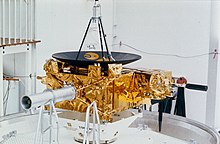
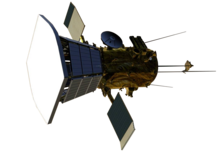
All these satellites have observed the Sun from the plane of the ecliptic, and so have only observed its equatorial regions in detail. The Ulysses probe was launched in 1990 to study the Sun's polar regions. It first traveled to Jupiter, to "slingshot" into an orbit that would take it far above the plane of the ecliptic. Once Ulysses was in its scheduled orbit, it began observing the solar wind and magnetic field strength at high solar latitudes, finding that the solar wind from high latitudes was moving at about 750 km/s, which was slower than expected, and that there were large magnetic waves emerging from high latitudes that scattered galactic cosmic rays.[196]
Elemental abundances in the photosphere are well known from spectroscopic studies, but the composition of the interior of the Sun is more poorly understood. A solar wind sample return mission, Genesis, was designed to allow astronomers to directly measure the composition of solar material.[197]
- Parker Solar Probe was launched in 2018 aboard a Delta IV Heavy rocket and will reach a perihelion of 0.046 AU in 2025, making it the closest-orbiting manmade satellite as the first spacecraft to fly low into the solar corona.[200]
- Solar Orbiter mission (SolO) was launched in 2020 and will reach a minimum perihelion of 0.28 AU, making it the closest satellite with sun-facing cameras.[201]
- CubeSat for Solar Particles (CuSP) was launched as a rideshare on Artemis 1 on 16 November 2022 to study particles and magnetic fields.
- Indian Space Research Organisation has launched a 100 kg satellite named Aditya-L1 on 2 September 2023.[202] Its main instrument will be a coronagraph for studying the dynamics of the solar corona.[203]
Unsolved problems
Coronal heating
Why is the Sun's corona so much hotter than the Sun's surface?
The temperature of the photosphere is approximately 6,000 K, whereas the temperature of the corona reaches 1,000,000–2,000,000 K.
It is thought that the energy necessary to heat the corona is provided by turbulent motion in the convection zone below the photosphere, and two main mechanisms have been proposed to explain coronal heating.
Currently, it is unclear whether waves are an efficient heating mechanism. All waves except Alfvén waves have been found to dissipate or refract before reaching the corona.[206] In addition, Alfvén waves do not easily dissipate in the corona. Current research focus has therefore shifted towards flare heating mechanisms.[79]
Faint young Sun
How could the early Earth have had liquid water if the Sun's output is predicted to have only been 70% as intense as it is today?
Theoretical models of the Sun's development suggest that 3.8 to 2.5 billion years ago, during the Archean eon, the Sun was only about 75% as bright as it is today. Such a weak star would not have been able to sustain liquid water on Earth's surface, and thus life should not have been able to develop. However, the geological record demonstrates that Earth has remained at a fairly constant temperature throughout its history and that the young Earth was somewhat warmer than it is today. One theory among scientists is that the atmosphere of the young Earth contained much larger quantities of greenhouse gases (such as carbon dioxide, methane) than are present today, which trapped enough heat to compensate for the smaller amount of solar energy reaching it.[207]
However, examination of Archaean sediments appears inconsistent with the hypothesis of high greenhouse concentrations. Instead, the moderate temperature range may be explained by a lower surface albedo brought about by less continental area and the lack of biologically induced cloud condensation nuclei. This would have led to increased absorption of solar energy, thereby compensating for the lower solar output.[208]
Observation by eyes

The brightness of the Sun can cause pain from looking at it with the naked eye; however, doing so for brief periods is not hazardous for normal non-dilated eyes.[209][210] Looking directly at the Sun (sungazing) causes phosphene visual artifacts and temporary partial blindness. It also delivers about 4 milliwatts of sunlight to the retina, slightly heating it and potentially causing damage in eyes that cannot respond properly to the brightness.[211][212] Viewing of the direct Sun with the naked eye can cause UV-induced, sunburn-like lesions on the retina beginning after about 100 seconds, particularly under conditions where the UV light from the Sun is intense and well focused.[213][214]
Viewing the Sun through light-concentrating optics such as binoculars may result in permanent damage to the retina without an appropriate filter that blocks UV and substantially dims the sunlight. When using an attenuating filter to view the Sun, the viewer is cautioned to use a filter specifically designed for that use. Some improvised filters that pass UV or IR rays, can actually harm the eye at high brightness levels.[215] Brief glances at the midday Sun through an unfiltered telescope can cause permanent damage.[216]
During sunrise and sunset, sunlight is attenuated because of
An
Religious aspects

Solar deities play a major role in many world religions and mythologies..
The ancient

From at least the
In
In the
See also
- Advanced Composition Explorer – NASA satellite of the Explorer program
- Analemma – Diagrammatic representation of Sun's position over a period of time
- Antisolar point – Point on the celestial sphere opposite Sun
- Circled dot– other uses of the Sun symbol and similar symbols
- List of brightest stars – Stars sorted by apparent magnitude
- List of nearest stars and brown dwarfs – Stars and brown dwarfs within 20 light years of the Solar System
- Midnight sun – Natural phenomenon when daylight lasts for a whole day
- Planets in astrology § Sun
- Solar telescope – Telescope used to observe the Sun
- Sun path – Arc-like path that the Sun appears to follow across the sky
- Sun-Earth Day – NASA and ESA joint educational program
- Timeline of the far future – Scientific projections regarding the far future
Notes
- ^ short scale. One billion is 109, or 1,000,000,000.
- ^ In astronomical sciences, the term heavy elements (or metals) refers to all chemical elements except hydrogen and helium.
- Hydrothermal vent communities live so deep under the sea that they have no access to sunlight. Bacteria instead use sulfur compounds as an energy source, via chemosynthesis.
- ^ Counterclockwise is also the direction of revolution around the Sun for objects in the Solar System and is the direction of axial spin for most objects.
- ^ Earth's atmosphere near sea level has a particle density of about 2×1025 m−3.
References
- ^ a b "Sol". Oxford English Dictionary (Online ed.). Oxford University Press. (Subscription or participating institution membership required.)
- ^ a b "Helios". Lexico UK English Dictionary. Oxford University Press. Archived from the original on 27 March 2020.
- ^ a b "solar". Oxford English Dictionary (Online ed.). Oxford University Press. (Subscription or participating institution membership required.)
- from the original on 9 July 2019. Retrieved 13 July 2019.
- ^ NASA Goddard Space Flight Center. Archivedfrom the original on 15 July 2010. Retrieved 12 August 2013.
- ^ Zombeck, Martin V. (1990). Handbook of Space Astronomy and Astrophysics 2nd edition. Cambridge University Press. Archived from the original on 3 February 2021. Retrieved 13 January 2016.
- S2CID 123824232.
- ^ "Eclipse 99: Frequently Asked Questions". NASA. Archived from the original on 27 May 2010. Retrieved 24 October 2010.
- ^ S2CID 119235554.
- S2CID 3629998.
- ^ a b c d e f "Solar System Exploration: Planets: Sun: Facts & Figures". NASA. Archived from the original on 2 January 2008.
- arXiv:1510.07674 [astro-ph.SR].
- S2CID 119255559.
- ^ S2CID 119436299.
- S2CID 21965292.(registration required)
- ^ David F. Gray (1992), The Inferred Color Index of the Sun Archived 5 July 2017 at the Wayback Machine, Publications of the Astronomical Society of the Pacific, vol. 104, no. 681, pp. 1035–1038 (November 1992).
- ^ "The Sun's Vital Statistics". Stanford Solar Center. Archived from the original on 14 October 2012. Retrieved 29 July 2008. Citing Eddy, J. (1979). A New Sun: The Solar Results From Skylab. NASA. p. 37. NASA SP-402. Archived from the original on 30 July 2021. Retrieved 12 July 2017.
- (PDF) from the original on 11 July 2020. Retrieved 12 April 2020.
- ^ S2CID 119302796.
- S2CID 21965292.
- ISBN 978-0-06-270084-1.
- ^ a b Vladimir Orel (2003) A Handbook of Germanic Etymology, Brill
- ASIN B000QS3QVQ.
- ^ "heliac". Oxford English Dictionary (Online ed.). Oxford University Press. (Subscription or participating institution membership required.)
- ^ "Opportunity's View, Sol 959 (Vertical)". NASA. 15 November 2006. Archived from the original on 22 October 2012. Retrieved 1 August 2007.
- ISBN 978-0-06-270084-1.
- ^ Than, K. (2006). "Astronomers Had it Wrong: Most Stars are Single". Space.com. Archived from the original on 21 December 2010. Retrieved 1 August 2007.
- S2CID 8400400.
- ^ ISBN 978-0-03-006228-5.
- S2CID 4240932.
- S2CID 189796439.
- Bibcode:1998A&A...333..231B.
- US Naval Observatory. 31 January 2008. Archivedfrom the original on 13 October 2007. Retrieved 17 July 2009.
- ^ Cain, Fraser (15 April 2013). "How long does it take sunlight to reach the Earth?". phys.org. Archived from the original on 2 March 2022. Retrieved 2 March 2022.
- ISBN 978-0-684-85618-6. Archivedfrom the original on 17 April 2021. Retrieved 3 November 2020.
- ISBN 978-3-642-14651-0.
- ISBN 978-0-521-39788-9.
- Bibcode:2000A&A...355..365G. Archived from the original(PDF) on 10 May 2011. Retrieved 22 February 2006.
- ^ "How Round is the Sun?". NASA. 2 October 2008. Archived from the original on 29 March 2019. Retrieved 7 March 2011.
- ^ "First Ever STEREO Images of the Entire Sun". NASA. 6 February 2011. Archived from the original on 8 March 2011. Retrieved 7 March 2011.
- ^ Jones, G. (16 August 2012). "Sun is the most perfect sphere ever observed in nature". The Guardian. Archived from the original on 3 March 2014. Retrieved 19 August 2013.
- ISBN 978-0-521-45506-0.
- ISBN 978-0-521-39788-9.
- ^ "The Anticlockwise Solar System". Australian Space Academy. Archived from the original on 7 August 2020. Retrieved 2 July 2020.
- ^ Bibcode:2003M&PSA..38.5272L. Archived(PDF) from the original on 13 May 2011. Retrieved 3 August 2008.
- ISBN 978-0-387-20089-7.
- S2CID 233738140.
- S2CID 257912497.
- ISBN 978-0-387-20089-7.
- ISBN 978-0-387-20089-7.
- ^ Iben, I Jnr (1965) "Stellar Evolution. II. The Evolution of a 3 M_{sun} Star from the Main Sequence Through Core Helium Burning". (Astrophysical Journal, vol. 142, p. 1447)
- S2CID 119759834.
- ^ S2CID 35285705.
- S2CID 11044272.
- ^ a b c d e f g "NASA/Marshall Solar Physics". Marshall Space Flight Center. 18 January 2007. Archived from the original on 29 March 2019. Retrieved 11 July 2009.
- Bibcode:2003phco.conf...21B. Archivedfrom the original on 21 April 2017. Retrieved 12 August 2013.
- S2CID 4776237.
- from the original on 27 November 2020. Retrieved 26 November 2020.
- ^ ISBN 978-0-521-39788-9.
- ISBN 978-0-691-05781-1.
- ISBN 978-0-935702-05-7.
- ^ "Ask Us: Sun". Cosmicopia. NASA. 2012. Archived from the original on 3 September 2018. Retrieved 13 July 2017.
- ^ Cohen, H. (9 November 1998). "Table of temperatures, power densities, luminosities by radius in the Sun". Contemporary Physics Education Project. Archived from the original on 29 November 2001. Retrieved 30 August 2011.
- ^ "Lazy Sun is less energetic than compost". Australian Broadcasting Corporation. 17 April 2012. Archived from the original on 6 March 2014. Retrieved 25 February 2014.
- S2CID 14622069.
- ^ Myers, S.T. (18 February 1999). "Lecture 11 – Stellar Structure I: Hydrostatic Equilibrium". Introduction to Astrophysics II. Archived from the original on 12 May 2011. Retrieved 15 July 2009.
- ^ a b c d e "Sun". World Book at NASA. NASA. Archived from the original on 10 May 2013. Retrieved 10 October 2012.
- ISBN 978-0-8493-3355-2. Archivedfrom the original on 29 October 2020. Retrieved 22 August 2020.
- ISBN 978-3-540-41064-5. Archivedfrom the original on 17 April 2021. Retrieved 22 August 2020.
- ^ Bibcode:1977BASI....5...40A. Archivedfrom the original on 12 May 2020. Retrieved 12 July 2009.
- ASIN B0006C7RS0.
- ISBN 978-0-935702-64-4.
- doi:10.1086/186829.
- ^ Parnel, C. "Discovery of Helium". University of St Andrews. Archived from the original on 7 November 2015. Retrieved 22 March 2006.
- ^ ""Beyond the Blue Horizon" – A Total Solar Eclipse Chase". 5 August 1999. Archived from the original on 2 July 2018. Retrieved 16 January 2022.
- S2CID 27696504.
- S2CID 33655095.
- ^ doi:10.1086/304111.
- ^ .
- ^ a b c d e Dwivedi, B.N. (2006). "Our ultraviolet Sun" (PDF). Current Science. 91 (5): 587–595. Archived (PDF) from the original on 25 October 2020. Retrieved 22 March 2015.
- ^ ISBN 978-0-87590-984-4. Archived(PDF) from the original on 1 October 2018. Retrieved 11 July 2009.
- ISBN 978-0-521-81057-9.
- ^ "A Star with two North Poles". Science @ NASA. NASA. 22 April 2003. Archived from the original on 18 July 2009.
- . CiteID 1136.
- ^ "The Distortion of the Heliosphere: Our Interstellar Magnetic Compass" (Press release). European Space Agency. 2005. Archived from the original on 4 June 2012. Retrieved 22 March 2006.
- ISBN 978-1-329-02202-7.
- ^ "Voyager – the Interstellar Mission". Archived from the original on 14 September 2017. Retrieved 14 May 2021.
- ^ Dunbar, Brian (2 March 2015). "Components of the Heliosphere". NASA. Archived from the original on 8 August 2021. Retrieved 20 March 2021.
- ^ a b c Hatfield, Miles (13 December 2021). "NASA Enters the Solar Atmosphere for the First Time". NASA. Archived from the original on 27 December 2021. Retrieved 30 July 2022.
 This article incorporates text from this source, which is in the public domain.
This article incorporates text from this source, which is in the public domain.
- ^ "GMS: Animation: NASA's Parker Solar Probe Enters Solar Atmosphere". svs.gsfc.nasa.gov. 14 December 2021. Archived from the original on 4 October 2022. Retrieved 30 July 2022.
- ^ "SVS: Parker Solar Probe: Crossing the Alfven Surface". svs.gsfc.nasa.gov. 14 December 2021. Archived from the original on 8 August 2022. Retrieved 30 July 2022.
 This article incorporates text from this source, which is in the public domain.
This article incorporates text from this source, which is in the public domain.
- ^ "What Color is the Sun?". Universe Today. Archived from the original on 25 May 2016. Retrieved 23 May 2016.
- ^ "What Color is the Sun?". Stanford Solar Center. Archived from the original on 30 October 2017. Retrieved 23 May 2016.
- Optics & Photonics News: 12–13. Archived from the originalon 18 June 2012.
- ^ Karl S. Kruszelnicki (17 April 2012). "Dr Karl's Great Moments In Science: Lazy Sun is less energetic than compost". Australian Broadcasting Corporation. Archived from the original on 6 March 2014. Retrieved 25 February 2014.
Every second, the Sun burns 620 million tonnes of hydrogen...
- ^ "Construction of a Composite Total Solar Irradiance (TSI) Time Series from 1978 to present". Archived from the original on 1 August 2011. Retrieved 5 October 2005.
- ISBN 978-0-8493-3078-0.
- ^ "Solar radiation" (PDF). Archived (PDF) from the original on 1 November 2012. Retrieved 29 December 2012.
- ^ "Reference Solar Spectral Irradiance: Air Mass 1.5". Archived from the original on 12 May 2019. Retrieved 12 November 2009.
- ISBN 978-0-521-39788-9.
- PMID 14551921.
- ^ "Ancient sunlight". Technology Through Time. NASA. 2007. Archived from the original on 15 May 2009. Retrieved 24 June 2009.
- S2CID 118656812.
- S2CID 117848623.
- S2CID 17829477.
- ISBN 978-0-691-05781-1.
- ISBN 978-3-540-76952-1.
- S2CID 7332154.
- ^ "The Largest Sunspot in Ten Years". Goddard Space Flight Center. 30 March 2001. Archived from the original on 23 August 2007. Retrieved 10 July 2009.
- doi:10.1086/142452.
- PhysOrg. 4 January 2008. Archivedfrom the original on 6 April 2008. Retrieved 10 July 2009.
- ^ "Sun flips magnetic field". CNN. 16 February 2001. Archived from the original on 21 January 2015. Retrieved 11 July 2009.
- ^ Phillips, T. (15 February 2001). "The Sun Does a Flip". NASA. Archived from the original on 12 May 2009. Retrieved 11 July 2009.
- ISBN 978-0-691-05781-1.
- S2CID 4273483.
- S2CID 33896851.
- from the original on 11 May 2020. Retrieved 16 December 2019.
- ISBN 978-0-7923-6545-7. Archivedfrom the original on 17 April 2021. Retrieved 3 November 2020.
- ^ Johnson-Groh, Mara (17 December 2019). "SDO sees new kind of magnetic explosion on sun". phys.org. Archived from the original on 27 January 2022. Retrieved 28 July 2022.
- ^ "The 100 nearest star systems". astro.gsu.edu. Archived from the original on 12 November 2007. Retrieved 30 April 2022.
- ISBN 978-0-691-05781-1.
- S2CID 24923770.
- S2CID 4304613.
- S2CID 118354201.
- ^ Glozman, Igor (2022). "Formation of the Solar System". Highline College. Des Moines, WA. Archived from the original on 26 March 2023. Retrieved 16 January 2022.
- S2CID 119204765.
- Bibcode:2010exop.book..347L.
- ThoughtCo. Archivedfrom the original on 11 July 2023. Retrieved 16 January 2023.
- ^ "Astronomers Find Sun's Sibling 'HD 162826'". Nature World News. 9 May 2014. Archived from the original on 3 March 2016. Retrieved 16 January 2022.
- ^ Matt Williams (21 November 2018). "Astronomers Find One of the Sun's Sibling Stars. Born From the Same Solar Nebula Billions of Years Ago". Universe Today. Archived from the original on 26 March 2023. Retrieved 7 October 2022.
- ISBN 978-1-891389-16-0. Archivedfrom the original on 30 October 2020. Retrieved 22 August 2020.
- ^ Source, News Staff / (12 August 2022). "ESA's Gaia Mission Sheds New Light on Past and Future of Our Sun | Sci.News". Sci.News: Breaking Science News. Archived from the original on 4 April 2023. Retrieved 15 August 2022.
- ^ ISBN 978-1-108-42216-1.
- ^ "Earth Won't Die as Soon as Thought". 22 January 2014. Archived from the original on 12 November 2020. Retrieved 24 May 2015.
- PMID 35350860.
- ^ Nola Taylor Redd. "Red Giant Stars: Facts, Definition & the Future of the Sun". space.com. Archived from the original on 9 February 2016. Retrieved 20 February 2016.
- ^ S2CID 10073988.
- S2CID 561413.
- ^ "The End Of The Sun". Archived from the original on 22 May 2019. Retrieved 24 May 2015.
- doi:10.1086/173033.
- Bibcode:1995A&A...297..727B.
- Bibcode:1995A&A...299..755B.
- ^ Johnson-Groh, Mara (25 August 2020). "The end of the universe may be marked by 'black dwarf supernova' explosions". Live Science. Archived from the original on 2 June 2023. Retrieved 24 November 2023.
- ^ Lewis, John, ed. (2004). Physics and Chemistry of the Solar System (2 ed.). Elsevier. p. 147.
- PMID 31235834. Although this paper was retracted by the journal because of an error about the distance between the Sun and Earth, Figure 5 is based on another paper and is unaffected by the problem.
- doi:10.1086/109714. Archived(PDF) from the original on 22 March 2020. Retrieved 22 March 2020. The value of 24° comes from (360)(15 J − 6 S)/(S − J), where S and J are the periods of Saturn and Jupiter respectively.
- PMID 32132618.
- ISSN 2041-8205.
- S2CID 203642080. 41.
- from the original on 3 October 2021. Retrieved 11 September 2021.
- ^ "Our Local Galactic Neighborhood". NASA. 5 June 2013. Archived from the original on 21 November 2013.
- ^ S2CID 203642080.
- from the original on 17 April 2022. Retrieved 1 April 2022.
- S2CID 210086520.
- S2CID 54224451. 13.
- S2CID 210086520.
- S2CID 40618530. L17.
- .
- ^ "StarChild Question of the Month – Does the Sun move around the Milky Way?". NASA. February 2000. Archived from the original on 30 October 2023.
- ^ Siegel, Ethan (30 August 2018). "Our Motion Through Space Isn't A Vortex, But Something Far More Interesting". Forbes. Archived from the original on 25 November 2023. Retrieved 25 November 2023.
- ^ Currin, Grant (30 August 2020). "How long is a galactic year?". Live Science. Archived from the original on 25 November 2023. Retrieved 25 November 2023.
- ISBN 978-0-521-80840-8.
- S2CID 161940013.
- JSTOR 1006040.
- University of Cairo.
- ^ "Galileo Galilei (1564–1642)". BBC. Archived from the original on 29 September 2018. Retrieved 22 March 2006.
- ^ A short History of scientific ideas to 1900, C. Singer, Oxford University Press, 1959, p. 151.
- ^ The Arabian Science, C. Ronan, pp. 201–244 in The Cambridge Illustrated History of the World's Science, Cambridge University Press, 1983; at pp. 213–214.
- S2CID 120700705.
- ^ "Sir Isaac Newton (1643–1727)". BBC Teach. BBC. Archived from the original on 10 March 2015. Retrieved 22 March 2006.
- ^ "Herschel Discovers Infrared Light". Cool Cosmos. Archived from the original on 25 February 2012. Retrieved 22 March 2006.
- ^ a b Thomson, W. (1862). "On the Age of the Sun's Heat". Macmillan's Magazine. 5: 388–393. Archived from the original on 25 September 2006. Retrieved 25 August 2006.
- .
- Bibcode:1890mhsr.book.....L.
- ^ Darden, L. (1998). "The Nature of Scientific Inquiry". Archived from the original on 17 August 2012. Retrieved 25 August 2006.
- ISBN 978-0-553-80202-3.
- ^ "Studying the stars, testing relativity: Sir Arthur Eddington". Space Science. European Space Agency. 2005. Archived from the original on 20 October 2012. Retrieved 1 August 2007.
- .
- S2CID 36146598.
- (PDF) from the original on 23 July 2018. Retrieved 12 April 2020.
- ^ Wade, M. (2008). "Pioneer 6-7-8-9-E". Encyclopedia Astronautica. Archived from the original on 22 April 2006. Retrieved 22 March 2006.
- ^ "Solar System Exploration: Missions: By Target: Our Solar System: Past: Pioneer 9". NASA. Archived from the original on 2 April 2012. Retrieved 30 October 2010.
NASA maintained contact with Pioneer 9 until May 1983
- ^ from the original on 13 July 2020. Retrieved 25 August 2019.
- ^ .
- ^ Ross and Aller 1976, Withbroe 1976, Hauge and Engvold 1977, cited in Biemont 1978.
- ^ Corliss and Bozman (1962 cited in Biemont 1978) and Warner (1967 cited in Biemont 1978)
- ^ Smith (1976 cited in Biemont 1978)
- ^ Signer and Suess 1963; Manuel 1967; Marti 1969; Kuroda and Manuel 1970; Srinivasan and Manuel 1971, all cited in Manuel and Hwaung 1983
- ^ Kuroda and Manuel 1970 cited in Manuel and Hwaung 1983:7
- ^ .
- ^ Burkepile, C.J. (1998). "Solar Maximum Mission Overview". Archived from the original on 5 April 2006. Retrieved 22 March 2006.
- Japan Aerospace Exploration Agency. 2005. Archived from the originalon 10 August 2013. Retrieved 22 March 2006.
- ^ "Mission extensions approved for science missions". ESA Science and Technology. 7 October 2009. Archived from the original on 2 May 2013. Retrieved 16 February 2010.
- ^ "NASA Successfully Launches a New Eye on the Sun". NASA Press Release Archives. 11 February 2010. Archived from the original on 10 August 2013. Retrieved 16 February 2010.
- US Naval Research Laboratory). Archivedfrom the original on 25 May 2015. Retrieved 19 March 2009.
- ^ JPL/CALTECH (2005). "Ulysses: Primary Mission Results". NASA. Archived from the original on 6 January 2006. Retrieved 22 March 2006.
- from the original on 11 May 2020. Retrieved 13 July 2019.
- ^ "STEREO Spacecraft & Instruments". NASA Missions. 8 March 2006. Archived from the original on 23 May 2013. Retrieved 30 May 2006.
- (PDF) from the original on 14 December 2019. Retrieved 25 August 2019.
- ^ Meghan Bartels. "Our sun will never look the same again thanks to two solar probes and one giant telescope". Space.com. Archived from the original on 2 March 2020. Retrieved 9 March 2020.
- ^ "Solar Orbiter". esa.int. Archived from the original on 29 March 2022. Retrieved 29 March 2022.
- ^ Kumar, Chethan (2 February 2022). "2 key Gaganyaan crew abort tests, Aditya top priority". The Times of India. Archived from the original on 18 February 2022. Retrieved 2 February 2022.
- ^ "Aditya L-1: After Chandrayaan 2, ISRO to pursue India's first mission to the Sun in 2020". Tech2. 25 July 2019. Archived from the original on 2 August 2019. Retrieved 2 August 2019.
- .
- doi:10.1086/166485.
- hdl:2060/19800019786.
- from the original on 26 September 2019. Retrieved 13 July 2019.
- S2CID 205220182.
- PMID 5551296.
- PMID 1209815.
- PMID 8325420.
- PMID 4707624.
- S2CID 4283242.
- ISBN 978-0-306-40328-6.
- ISBN 978-0-8251-4500-1. Archivedfrom the original on 3 November 2020. Retrieved 22 August 2020.
- ISBN 978-1-4614-3824-3.
Never look directly at the Sun through any form of optical equipment, even for an instant. A brief glimpse of the Sun through a telescope is enough to cause permanent eye damage, or even blindness. Even looking at the Sun with the naked eye for more than a second or two is not safe. Do not assume that it is safe to look at the Sun through a filter, no matter how dark the filter appears to be.
- S2CID 2349082.
- S2CID 118819800.
- ^ "The Green Flash". BBC. Archived from the original on 16 December 2008. Retrieved 10 August 2008.
- ISBN 978-1-78404-478-7.
- ^ ISBN 978-0-7141-1705-8. Archivedfrom the original on 20 November 2020. Retrieved 22 August 2020.
- ^ ISBN 978-0-313-29497-6.
- ISBN 978-0-521-84855-8.
- ISBN 978-0-486-41138-5.
- ^ "Planet". Oxford Dictionaries. December 2007. Archived from the original on 2 April 2015. Retrieved 22 March 2015.
- S2CID 118875902.
- ISBN 978-0-691-00260-6.
- ISBN 978-1-884964-98-5. (EIEC). Archivedfrom the original on 31 March 2017. Retrieved 20 October 2017.
- ^ ISBN 978-0-500-27616-7.
- ^ Hesiod, Theogony 371 Archived 15 September 2021 at the Wayback Machine
- ISBN 978-0-674-36281-9.
- ^ Malachi 4:2
- ^ Bible, Book of Malachi. King James Version. Archived from the original on 20 October 2017. Retrieved 20 October 2017.
- ^ Spargo, Emma Jane Marie (1953). The Category of the Aesthetic in the Philosophy of Saint Bonaventure. St. Bonaventure, New York; E. Nauwelaerts, Louvain, Belgium; F. Schöningh, Paderborn, Germany: The Franciscan Institute. p. 86. Archived from the original on 17 April 2021. Retrieved 3 November 2020.
- ISBN 978-0-312-18723-1. Archivedfrom the original on 18 May 2016. Retrieved 15 November 2015.
- ^ a b Townsend, Richard (1979). State and Cosmos in the Art of Tenochtitlan. Washington, DC: Dumbarton Oaks. p. 66.
- ^ ISBN 978-1-60413-435-3.
- ISBN 978-1-4254-8787-4.
Further reading
- Cohen, Richard (2010). Chasing the Sun: The Epic Story of the Star That Gives Us Life. Simon & Schuster. ISBN 978-1-4000-6875-3.
- Hudson, Hugh (2008). "Solar Activity". .
- Thompson, M.J. (August 2004). "Solar interior: Helioseismology and the Sun's interior". .
External links
- Astronomy Cast: The Sun
- Satellite observations of solar luminosity Archived 11 June 2017 at the Wayback Machine
- Animation – The Future of the Sun
- "Thermonuclear Art – The Sun In Ultra-HD" | Goddard Space Flight Center
- "A Decade of Sun" | Goddard Space Flight Center


